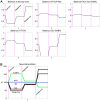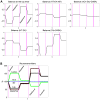A heuristic model of alcohol dependence
- PMID: 24658530
- PMCID: PMC3962390
- DOI: 10.1371/journal.pone.0092221
A heuristic model of alcohol dependence
Abstract
Background: Substance dependence poses a critical health problem. Sadly, its neurobiological mechanisms are still unclear, and this lack of real understanding is reflected in insufficient treatment options. It has been hypothesized that alcohol effects are due to an imbalance between neuroexcitatory and neuroinhibitory amino acids. However, glutamate and GABA interact with other neurotransmitters, which form a complicated network whose functioning evades intuition and should be investigated systemically with methods of biomedical systems analysis.
Methods and results: We present a heuristic model of neurotransmitters that combines a neurochemical interaction matrix at the biochemical level with a mobile describing the balances between pairs of neurotransmitters at the physiological and behavioral level. We investigate the effects of alcohol on the integrated neurotransmitter systems at both levels. The model simulation results are consistent with clinical and experimental observations. The model demonstrates that the drug diazepam for symptoms of alcohol withdrawal effectively reduces the imbalances between neurotransmitters. Moreover, the acetylcholine signal is suggested as a novel target for treatment of symptoms associated with alcohol withdrawal.
Conclusions: Efficient means of integrating clinical symptoms across multiple levels are still scarce and difficult to establish. We present a heuristic model of systemic neurotransmitter functionality that permits the assessment of genetic, biochemical, and pharmacological perturbations. The model can serve as a tool to represent clinical and biological observations and explore various scenarios associated with alcohol dependence and its treatments. It also is very well suited for educational purposes.
Conflict of interest statement
Figures






Similar articles
-
A heuristic model for working memory deficit in schizophrenia.Biochim Biophys Acta. 2016 Nov;1860(11 Pt B):2696-705. doi: 10.1016/j.bbagen.2016.04.031. Epub 2016 May 10. Biochim Biophys Acta. 2016. PMID: 27177811 Free PMC article.
-
Imbalance between neuroexcitatory and neuroinhibitory amino acids causes craving for ethanol.Addict Behav. 2004 Sep;29(7):1325-39. doi: 10.1016/j.addbeh.2004.06.020. Addict Behav. 2004. PMID: 15345268
-
[Neurobiology of alcohol withdrawal inhibitory and excitatory neurotransmitters].Turk Psikiyatri Derg. 2006 Summer;17(2):129-37. Turk Psikiyatri Derg. 2006. PMID: 16755413 Review. Turkish.
-
How Imaging Glutamate, γ-Aminobutyric Acid, and Dopamine Can Inform the Clinical Treatment of Alcohol Dependence and Withdrawal.Alcohol Clin Exp Res. 2015 Dec;39(12):2268-82. doi: 10.1111/acer.12893. Epub 2015 Oct 28. Alcohol Clin Exp Res. 2015. PMID: 26510169 Free PMC article. Review.
-
Gamma-aminobutyric acid type A receptors and alcoholism: intoxication, dependence, vulnerability, and treatment.Arch Gen Psychiatry. 2006 Sep;63(9):957-68. doi: 10.1001/archpsyc.63.9.957. Arch Gen Psychiatry. 2006. PMID: 16952998 Review.
Cited by
-
A heuristic model for working memory deficit in schizophrenia.Biochim Biophys Acta. 2016 Nov;1860(11 Pt B):2696-705. doi: 10.1016/j.bbagen.2016.04.031. Epub 2016 May 10. Biochim Biophys Acta. 2016. PMID: 27177811 Free PMC article.
-
The Quest for System-Theoretical Medicine in the COVID-19 Era.Front Med (Lausanne). 2021 Mar 29;8:640974. doi: 10.3389/fmed.2021.640974. eCollection 2021. Front Med (Lausanne). 2021. PMID: 33855036 Free PMC article.
-
Perspectives of (/memorandum for) systems thinking on COVID-19 pandemic and pathology.J Eval Clin Pract. 2023 Apr;29(3):415-429. doi: 10.1111/jep.13772. Epub 2022 Sep 28. J Eval Clin Pract. 2023. PMID: 36168893 Free PMC article.
-
[Pain and opioid dependency as multilevel network phenomenon : Theoretical and metatheoretical aspects].Schmerz. 2016 Aug;30(4):339-45. doi: 10.1007/s00482-016-0146-1. Schmerz. 2016. PMID: 27422300 Review. German.
-
A Reliable Method Based on Liquid Chromatography-Tandem Mass Spectrometry for the Simultaneous Quantification of Neurotransmitters in Caenorhabditis elegans.Molecules. 2023 Jul 13;28(14):5373. doi: 10.3390/molecules28145373. Molecules. 2023. PMID: 37513246 Free PMC article.
References
-
- el-Guebaly N, el-Guebaly A (1981) Alcohol abuse in ancient Egypt: the recorded evidence. Int J Addict 16: 1207–1221. - PubMed
-
- Leibowitz JO (1967) Studies in the history of alcoholism. II. Acute alcoholism in ancient Greek and Roman medicine. Br J Addict Alcohol Other Drugs 62: 83–86. - PubMed
-
- American Psychiatric Association (2000) Diagnostic and Statistical Manual of Mental Disorders, Fourth Edition, Text Revision (DSM-IV-TR): Washington, DC: American Psychiatric Association.
-
- Carlson RW, Kumar NN, Wong-Mckinstry E, Ayyagari S, Puri N, et al. (2012) Alcohol withdrawal syndrome. Crit Care Clin 28: 549–585. - PubMed
-
- Guindon G, Boisclair D (2003) Past, Current and Future Trends in Tobacco Use. Health, Nutrition and Population (HNP) Discussion Paper (Economics of Tobacco Control Paper No. 6). Nutrition and Population (HNP) Discussion Paper: Washington, World Bank.
Publication types
MeSH terms
Substances
Grants and funding
LinkOut - more resources
Full Text Sources
Other Literature Sources
Medical

